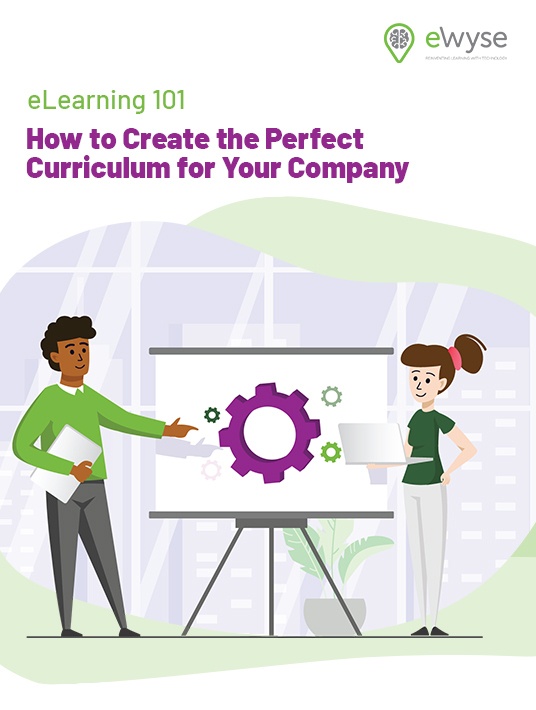Choosing The Correct Approach For eLearning Curriculum Development
There are many ways to build an educational program for employees. The key is knowing which one, or combination of multiple platforms, will best suit the needs of your company. Some companies will choose a 100% eLearning option, others will stick to a traditional in-person model, and still others will choose some combination of the two.
Whichever option a company chooses, it is of utmost importance that the type of training curriculum will meet company goals and needs, which will differ between companies. For example, some organizations might want to:
- Build employee skills based on their current challenges and competencies
- Build a curriculum that provides future-ready training
- Develop a learning program that allows employees to take the lead in their own development
The key is finding a way to balance all these different factors with the goals of your company. The more nuanced a program is, the more options you will have for creating an educational experience tailored to your employees’ needs.

Benefits Of eLearning
The benefits of eLearning are sizable, including lower overhead and travel expenses, ease of dissemination for employees and customers, and improved security and confidentiality.
In contrast to in-person delivery, eLearning allows organizations to deliver curriculum materials in an engaging virtual environment where employees can access training at their convenience. This translates into increased participation rates because the burden of scheduling is removed as well as increased retention rates, as content is available 24/7 and can be accessed anywhere with an Internet connection.
Much of the success of learning online has been due to the cost savings and the flexibility that an eLearning platform offers. Companies can immediately provide current information to employees
who need it and can also offer self-paced sessions that make it easier for people to work on their training during their own time.
eLearning Considerations
It’s important to balance the need for traditional face-to-face training over eLearning, or a combination of the two. Although some tasks are best taught online, others are best taught in person by an expert facilitator with plenty of supporting materials to help drive home important concepts. Here are some considerations around eLearning that need to be taken into account:
Self-Paced eLearning Is Effective For Most Training Material, But Sometimes As A Blended Approach
When the goal is to teach very difficult concepts or transfer nonverbal knowledge about how to solve more complex problems (e.g., customer service skills), an instructor giving hands-on teaching will usually provide better outcomes. There is verbal and body language that is often better conveyed in-person that works best for certain types of training. That’s not to say eLearning is not suited for this use case whatsoever - simply that in-person instruction maintains a slight edge in situations like this, which is a consideration you should make when factoring in the ROI for a particular task.
eLearning Is Not Always More Cost Effective (But It Usually Is)
By its nature, eLearning requires less upfront capital expenditures than in-person training. It’s been shown that organizations can save as much as 80% of their training costs by moving it online. However, companies should also take into consideration ongoing costs such as development and maintenance before deciding whether or not it’s cost effective to do everything virtually. This includes thinking about the more advanced features like simulations or 3D tools which require even greater expertise and ongoing development dollars.
eLearning May Not Be Better For Some Types Of Learners
Each employee is different, and some may prefer to learn online, while others in-person, and still others by independent reading. It is important to consider the variety of ways people learn when considering a new training curriculum.
When choosing a training curriculum, make sure you consider your company’s context and review both the benefits and limitations of eLearning.
How To Choose The Best Curriculum Development Approach
As we have seen, there are both significant advantages to eLearning as well as some other considerations. There is no one size fits all approach when it comes to building corporate training programs. Each company should carefully review its needs and strategy, then choose the approach that is best suited for its goals and culture. Some factors to consider include:
- What are the learning objectives?
- What content is needed?
- How will employees learn?
- What types of learners will be targeted?
- How much content might be created annually?
- How much can be created in house or by partners?
- What are the costs associated with various approaches?
Since eLearning has been shown to be so successful in the corporate world, the question is no longer whether or not to engage in eLearning; it’s how to optimize your investment in this innovative medium. To do this, you need to understand the different approaches for curriculum development that are available.
The approach you choose should be based on what your organization’s goals are. Some businesses want a short burst of training for existing employees while others want new hires to be trained continually until they become fully productive members of the team in order to reduce turnover rates and increase customer satisfaction levels.
An excellent approach to curriculum development is blended learning, which blends course content with real-time interaction between you (the instructor) and your learner while they ’re online engaged in some type of activity (i.e., taking a quiz). With this technique, you have the opportunity to coach them through any difficulties they may have with understanding specific content before moving on to the next lesson or quiz. There are three main approaches to achieve the best of both eLearning and in-person learning:
- Instructor-Led eLearning
- Computer-Assisted eLearning
- Blended Learning
Instructor-Led eLearning
This approach utilizes courses that are delivered primarily by a physical instructor and cover a wide range of topics within a course. You can tailor specific needs for each employee and cover more material in the same time period as other methods, as well as provide a more personalized approach. The downside is that it is less flexible and requires the learners and the instructors to be in the same geographical location, making it impractical in many cases.
Computer-Assisted eLearning
These courses are generally self-paced with some interaction with an instructor. This interaction is limited to email or phone calls rather than in-person meetings which makes it useful for remote workers who cannot be around each other in real time. There is typically more flexibility when they take these types of courses putting them on a more equal footing with regular offline education curriculums. The downside is that these types have less creativity involved than instructors who have their own style and personality.
Blended Learning
This approach combines both traditional teaching methods with modern technology such as interactive media or online discussion boards to create an engaging learning environment for learners that simulates real life experience. This approach has been found to increase learner engagement significantly. The downside is that this type of curriculum development requires additional investment at the start which may be hard for smaller companies without sufficient resources or larger companies.
There are so many options available for companies that want to utilize eLearning platforms for corporate training. It is important to understand the needs of your company and then select an option from those listed above that will best maximize your investment.
Making It Last
After you’ve selected an option that will be effective and maximize your investment into eLearning training, it is important to think about the longevity of your training. To maximize longevity, organizations must be mindful of the different approaches to curriculum development. A blended approach to curriculum development ensures longevity and a higher level of engagement from the learner.
There are a few different ways a company can approach eLearning, and those aspects can have a major impact on the longevity of the content. The best way to select which type of system would be best for your company is to identify which areas you want to focus on. Let’s look at a few systems and how they impact longevity and learning retention:
Self-Paced Learning
This is what we have come to know as traditional eLearning. Arguably the most cost-effective and flexible form of learning. Courses may be rapidly developed to fulfill a short-term goal (eg, sudden product changes, or for legal requirements), or designed in a way that they may be tweaked to maintain their relevance with up-to-date thinking, styles or branding.
Online Courseware
This type of system typically consists of static screens with text and images that the learner interacts with at their own pace and in the order they desire. There are typically quizzes at the end for reinforcement and assessment. This type of system is great for learning about specific subject matter (i.e., safety, marketing, etc.). This approach is often used by training managers who have a large team they are training in a certain subject matter, as it’s more efficient on a per-learner basis.
Web Conferencing
This type focuses more on group interactions between learners who are geographically dispersed by using videoconferencing and instant messaging tools. It provides a way for groups to come together, interact with one another, present ideas, take notes, ask questions, and brainstorm solutions together. It often produces more organic interaction among teammates and colleagues.
Virtual Reality Training Systems
These systems simulate complex environments where learners must use VR goggles or headsets in order to participate in training scenarios while navigating obstacles and problems learners can expect when they are performing tasks related to specific jobs like needle piercings or changing tires on cars.
Conclusion
Whatever approach you choose for developing your training curriculum, make sure it aligns with your goals as a company and your audience’s needs! To maximize longevity and create learning that lasts, it is important to consider the options available and select the best one. After all, employee training and curriculum development is an important part of your growth as a company!
Download the eBook eLearning 101: How To Create The Perfect Curriculum For Your Company to discover action points you can follow to launch a custom-tailored L&D strategy for your team. It's a must-read for companies that are weighing the pros and cons of outsourcing and want to learn more about curriculum design from industry experts.
Also, join the webinar to learn how to jump-start your eLearning initiatives by collaborating with a third-party provider!









